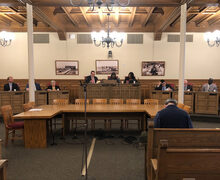Syracuse alumnus designs public artwork for local park
Courtesy of The Downtown Committee of Syracuse
Thick white lines wind their way through a blue courtyard, creating a diagonal pattern that stretches from Salina Street to Fayette Street; this is Perseverance Park, exactly as Jason Evans imagined it.
“I really wanted to revitalize this space,” he said. “I wanted to change how people see Syracuse. First and foremost, I want people to embrace the place.”
The painted courtyard, part of a public art installation called “Flowscape,” is less a permanent redesign than a call to action. The Downtown Committee of Syracuse has been brainstorming ways to make better use of Perseverance Park since the public transportation hub moved in 2012, and it hopes Evans’ design will invite citizens to contribute ideas.
Evans, a 2008 Syracuse University School of Architecture alumnus, works at Ashley McGraw Architects designing buildings. But projects like “Flowscape” allow him a creative outlet where he can practice graphic design while improving public spaces.
“This park used to be desolate,” Evans said. “There were bricks here, concrete there, a weird pattern over here. It was difficult, at first, imagining how to use this space. But it started to make sense eventually because people walk over it all the time. These diagonal white lines are representative of the people passing through here.”
The project was done in conjunction with several organizations, such as the Downtown Committee, the City of Syracuse Department of Public Works, the Public Art Commission and the Syracuse-Onondaga County Planning Agency.
Adria Finch, an economic development specialist at the Downtown Committee, walks alongside Evans as they observe the artwork underfoot. Finch helped coordinate the myriad of organizations involved with the project and said the process was relatively painless: all of the people involved were eager to help revitalize the city in any way possible.
“‘Flowscape’ is mainly an interim solution until we find a permanent change to the park,” she said. “Right now, we’re hoping that us being excited about the project will get others to be, too.”
Thirty-six volunteers spent a long weekend painting the courtyard until it was complete on the evening of June 2. If the turnout was any indication, people are getting excited. Finch said it was relatively inexpensive, too, as the group used traffic paint, giving “Flowscape” its “handicap parking spot” color scheme. The cost fell somewhere between $2,000-3,000.
The artwork sprawled on the floor of the park reflects that of “Arterie,” another one of Evans’ work that covers a nearby section of Erie Boulevard in a blue barcode design. While Finch and the various organizations take care of the clerical and economic aspects of projects like these, the creative development was left to Evans. But he wasn’t alone in designing “Flowscape.”
George Curry, professor emeritus at State University of New York College of Environmental Science and Forestry, was on hand to advise Evans during the creation of “Flowscape.” Curry approached the project from a logistical standpoint, imagining how people might use the space differently if they proceeded with the redesign.
“Syracuse can benefit greatly from having an increased art program,” Curry said. “The installations not only increase the quality of life for the residents, but also increase tourism, thus having a positive economic impact.”
Curry said he was told someone had seen a father and son using “Flowscape” to play a game, in which they rolled a ball back and forth along the diagonal lines Evans designed. It was a use of the artwork Curry didn’t foresee, but it was just the kind of interaction he hoped would emerge from “Flowscape.”
And Evans, after wanting nothing more than to escape Syracuse for college before returning to study architecture, discovered that the city is ripe for improvement. He stands still, hands in his pockets, and cranes his neck to see the top of a dead tree in the park. The white line of paint at the base continues up the tree’s trunk, until it reaches the spot where branches used to grow.
“A lot of people have this notion that nothing’s right in Syracuse,” Evans said. “I wanted to help change that perception. Cool things can happen here, and we can make the city inspiring and creative again.”
Published on June 12, 2014 at 4:52 pm





